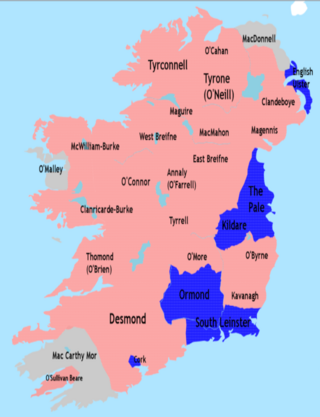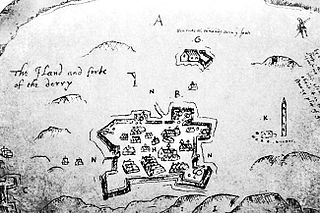
Charles Blount, 1st Earl of Devonshire, KG was an English nobleman and soldier who served as Lord Deputy of Ireland under Queen Elizabeth I, and later as Lord Lieutenant of Ireland under King James I.

Hugh O'Neill, was an Irish Gaelic lord, Earl of Tyrone and was later created The Ó Néill Mór, Chief of the Name. O'Neill's career was played out against the background of the Tudor conquest of Ireland, and he is best known for leading a coalition of Irish clans during the Nine Years' War, the strongest threat to the House of Tudor in Ireland since the uprising of Silken Thomas against King Henry VIII.

Sir Turlough Lynagh O'Neill was an Irish Gaelic lord of Tír Eoghain in early modern Ireland. He was inaugurated upon Shane O’Neill’s death, becoming The O'Neill. From 1567 to 1595, Sir Turlough Luineach O'Neill was leader of the O'Neill clan, the most powerful family in Ulster, the northern province in Ireland. He was knighted in 1578.

Shane O'Neill, was an Irish chieftain of the O'Neill dynasty of Ulster in the mid-16th century. Shane O'Neill's career was marked by his ambition to be the O'Neill—sovereign of the dominant O'Neill family of Tír Eoghain—and thus overlord of the entire province. This brought him into conflict with competing branches of the O'Neill family and with the English government in Ireland, who recognised a rival claim. Shane's support was considered worth gaining by the English even during the lifetime of his father Conn O'Neill, 1st Earl of Tyrone. But rejecting overtures from Thomas Radclyffe, 3rd Earl of Sussex, the lord deputy from 1556, Shane refused to help the English against the Scottish settlers on the coast of Antrim, allying himself for a short time instead with the MacDonnells, the most powerful of these settlers, Shane viewed the Scottish settlers as invaders, but decided to stay his hand against them with hopes of using them to strengthen his position with the English; however, tensions quickly boiled over and he declared war on the Scottish MacDonnell's defeating them at the Battle of Glentaisie despite the MacDonnells calling for reinforcements from Scotland. The Scottish MacDonnells would later assassinate Shane O'Neill and collect the bounty on his head.
The Earl of Tyrone is a title created three times in the Peerage of Ireland.

The Nine Years' War, sometimes called Tyrone's Rebellion, took place in Ireland from 1593 to 1603. It was fought between an Irish alliance—led mainly by Hugh O'Neill of Tyrone and Hugh Roe O'Donnell of Tyrconnell—against English rule in Ireland, and was a response to the ongoing Tudor conquest of Ireland. The war was fought in all parts of the country, but mainly in the northern province of Ulster. The Irish alliance won some important early victories, such as the Battle of Clontibret (1595) and the Battle of the Yellow Ford (1598), but the English won a decisive victory against the alliance and their Spanish allies in the siege of Kinsale (1601–02). The war ended with the Treaty of Mellifont (1603). Many of the defeated northern lords left Ireland to seek support for a new uprising in the Flight of the Earls (1607), never to return. This marked the end of Gaelic Ireland and led to the Plantation of Ulster.
The Battle of Moyry Pass was fought during September and October 1600 in counties Armagh and Louth, in the north of Ireland, during the Nine Years' War. It was the first significant engagement of forces following the cessation of arms agreed in the previous year between the Irish leader Hugh O'Neill and the English Crown commander, the Earl of Essex.
Hugh McShane O'Neill was an early modern Irish nobleman and rebel associated with the McShanes of Glenconkeyne and Killetra. This group was also called the "Wild Clan Shanes of Killetragh" or the "McShane-O'Neills". His parentage is disputed however he is claimed by some as being either a grandson or great-grandson of Conn O'Neill, 1st Earl of Tyrone, and Gearoid Mór Fitzgerald, 8th Earl of Kildare, and of the primary line of the O'Neill of Tyrone clan.

Sir Cahir O'Doherty was the last Gaelic Chief of the Name of Clan O'Doherty and Lord of Inishowen, in what is now County Donegal. O'Doherty was a noted loyalist during Tyrone's Rebellion and became known as the Queen's O'Doherty for his service on the Crown's side during the fighting. After the war O'Doherty had ambitions to become a courtier and applied for a position in the household of Henry Frederick, Prince of Wales, but he increasingly came into dispute with Irish-based officials such as the Viceroy Sir Arthur Chichester and the Governor of Derry Sir George Paulet. In 1608 he launched a rebellion, seizing Derry from Paulet and burning it to the ground. O'Doherty was subsequently killed in a battle at Kilmacrennan, and the rebellion swiftly collapsed.

Tír Eoghain, also known as Tyrone, was a kingdom and later earldom of Gaelic Ireland, comprising parts of present-day County Tyrone, County Armagh, County Londonderry and County Donegal (Raphoe). The kingdom represented the core homeland of the Cenél nEógain people of the Northern Uí Néill and although they ruled, there were smaller groups of other Gaels in the area. One part of the realm to the north-east broke away and expanded, becoming Clandeboye, ruled by a scion branch of the O'Neill dynasty. In one form or another, Tyrone existed for over a millennium. Its main capital was Dungannon, though kings were inaugurated at Tullyhogue Fort.

The O'Neill dynasty is a lineage of Irish Gaelic origin, that held prominent positions and titles in Ireland and elsewhere. As Kings of Cenél nEógain, they were historically the most prominent family of the Northern Uí Néill, along with the O'Donnell dynasty. The O'Neills hold that their ancestors were kings of Ailech during the Early Middle Ages, as descendants of Niall of the Nine Hostages.

O'Doherty's rebellion took place in 1608 when Sir Cahir O'Doherty, lord of Inishowen, began an uprising against the Crown authorities in the west of Ulster in the north-west of the Kingdom of Ireland. O'Doherty, a Gaelic chieftain, had been a long-standing supporter of the Crown, but having been angered at his treatment by local officials he launched an attack on Derry, burning the town. O'Doherty may have hoped to negotiate a settlement with the government, but, after his death in a skirmish at Kilmacrennan, the rebellion collapsed with the last survivors being besieged on Tory Island.

The Burning of Derry took place on 19 April 1608 during O'Doherty's Rebellion when Sir Cahir O'Doherty led a force of rebels to storm Derry in Ulster. He launched his rebellion with an attack on the garrison town of Derry, which was taken thanks to the element of surprise. The town was then almost entirely destroyed by fire.
Henry Hart (1566-1637) was an Anglo-Irish soldier and landowner of the Elizabethan and early Stuart eras. He served in the Nine Years' War (1584-1603) and was later involved in the opening incident of O'Doherty's Rebellion in 1608. As a servitor he acquired an estate in County Donegal.

Phelim Reagh MacDavitt or Phelim Reagh MacDevitt was a Gaelic Irish warrior and landowner notable for his participation in the Nine Years War and later in O'Doherty's Rebellion in 1608. After playing a leading part in the Burning of Derry, he was captured and executed following the Battle of Kilmacrennan.
Sir Cormac MacBaron O'Neill (d.1613) was an Irish soldier and landowner of the Elizabethan and early Stuart eras. He was part of the O'Neill dynasty, one of the most prominent Gaelic family in Ireland.
Art MacBaron O'Neill was an Irish landowner and soldier of the Elizabethan and early Stuart eras. He is sometimes referred to as Arthur O'Neill.
Brian MacArt O'Neill was a member of the O'Neill Dynasty, the leading Gaelic family of Ulster. He was the son and heir of Art MacBaron O'Neill of Oneilland and a grandson of Matthew O'Neill, 1st Baron Dungannon. He may have taken part in Tyrone's Rebellion, a conflict in which several of his brothers were killed. Along with the rest of his family he was pardoned as part of the Treaty of Mellifont in 1603.
Ellis MacDonnell, Countess of Antrim was an Irish aristocrat of the late Elizabethan and early Stuart eras.
Conn O'Neill was a member of the O'Neill dynasty, the most powerful Gaelic family in Ireland. He was the youngest son of Hugh O'Neill, Earl of Tyrone who had initially been a supporter of the Crown but led Tyrone's Rebellion between 1594–1603. He then made peace and was restored to royal favour following the Treaty of Mellifont. Conn's mother was Catherine O'Neill, Countess of Tyrone, from the Magennis family of Iveagh.








